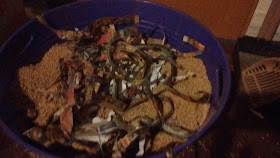This is Part One of the Zero-Waste Cat Composting Series
 |
| Cat box from thrift store, transitioning to shredded paper |
(Psst, read through for a bonus tip!)
Cats primarily create two kinds of waste, incoming and outgoing, if you catch my drift. Incoming waste (food and clean litter) can be reduced by reducing packaging and so can outgoing (yes, poop and used litter), but both still create some waste. Is there a way to produce no cat waste, i.e. trash?
If you have found a source of affordable, all-natural, healthy, and bulk dry cat food, bully for you. If you have only found cheap, unhealthy bulk cat food, then you are probably me. Good luck buying unpackaged meat for your cat for a price I will pay as well, unless we have more consistent meat scraps. Meat produces bones, which you can't put in your worm bin, city brown waste bin, or outdoor compost pile.
Outgoing waste from cats carries disease, shouldn't be flushed down the toilet, and will be in your regular trash bin if you follow the conventional rules. How very wasteful to throw it away where it can later get in our groundwater through poor dump maintenance. This waste also can't be composted directly in a worm bin, put in the city brown waste bin, or in your compost pile for your vegetable garden.
 |
| Shredded paper, ready to be used in the cat box |
So where to send the bones or poop/litter? Bokashi, my friend, bokashi bucket precomposting, black soldier fly composting, and cat poop composting.
Bokashi is often referred to as composting, but it is really more of a form of pickling. Yep, today you are going to learn how to pickle poop and kitchen waste. You use similar beneficial bacteria to yogurt, kefir, kombucha, etc. to precompost/pickle: meat scraps, break eggshells down, poop (with special care, see link for cat poop composting above), dairy, and other normal banished compost organics. Then you can compost as desired.
You can, of course, buy bokashi buckets
Here's the poop pickling process and stage 1 of our cat poop composting-
Here is my newspaper poop pickling juice starting to culture:
I used yogurt whey from our homemade yogurt, some of our bulk honey, and old sensitive info paperwork for the newspaper. After the paper is cultured, it will be air dried and ready for use as both a odor-reducing litter and pre-composter. After all, would you look through pickled poop for sensitive information?
Suffocate the Poop
After it's dried, keep it near your composter (container with a tight-fitting lid and no air holes). We're using an empty 5 gallon food storage bucket from our free wheat kernels for our bokashi cat poop composter. You want to pickle the poop, not raise a living, breathing mold monster.
Shred, fill, and (duck for) cover
To start using the bokashi composter, fill the bottom with 2-3 inches of absorbent material, shredded paper in our case and cover with a light layer of bokashi newspaper to prep the composter. (Bokashi newspaper not shown). Yes, you may create a duck shape for the bokashi cover.
The Daily Poop Scoop and Run
Once a day, add your organic materials (cat poop and shredded paper litter in our cat poop composter) to the composter/pickler and cover with bokashi newspaper/bran. Close lid tightly and do not disturb for 24 hours.
And the Poop Goes to...
Keep using until full, and then let rest for a week undisturbed. Empty bokashi compost into a black soldier fly composter (in our poop case), worm bin, or outdoor bin.
*Bonus- Use some of the newspaper bokashi as cat litter to reduce odors.
Until next time, happy pickling!
Little Urban Greenie
Shared at: Bouquet of Talent Party, Home Design Inspirations Party, Inspiration Galore Party Project, Nifty Thrifty Party, Inspiration Monday, Makers Make Party, Mix It Up Monday, Creative Corner, Creative Gallery, A Round Tuit, Block Party, The Scoop Link Party, Create Link Inspire Party, Clever Chicks Bloghop, Lou Lou Girls' Fabulous Party, Project Inspire, Totally Terrific Tuesday Link Party, Home Away From Home Party, Inspire Me Tuesday, Share It Tuesday, Creative Muster Party, Urban Naturale Blog Hop, Homestead Blog Hop, Wow Us Wednesdays, Homesteader Blog Hop, Wonderful Wednesday Blop Hop, Wednesday AIM Link Party, Wise Woman Linkup, Wine'd Down Wednesdays, Wildly Original Link Party, Be Clean Be Green With Kids Linkup, Waste Less Wednesdays Wow Me Wednesdays, Artsy Fartsy Link Party, Think Tank Thursday Link Up, This is How We Roll Thursday, Simple Homestead Bloghop, Foodie Friends Friday Link Up Party, What to Do Weekends Party, Pretty Pintastic Party, Pinworthy Projects Party, Home Matters Party, Friday Feature Linky Party, Friendship Friday, Frenzy Friday, Dear Creatives Linkup, Simple Saturdays Bloghop, Dare to Share Linkup, Saturday Sharefest, Share One More Time Party, Create Bake Make Party



No comments:
Post a Comment